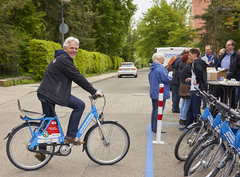Zusammenhänge zwischen Berufspendeln und Herz-Kreislauf-Erkrankungen [07.06.23]
Micha Kaiser, Alfonso Sousa-Poza und Kollegen stellen in einem gerade erschienenen Artikel ihre Ergebnisse aus einer Biomarker-basierten Analyse von Querschnittskohorten vor. Die Studie ergibt, dass die untersuchten CVD-Biomarker und assoziierte gesundheitlichen Folgen positiv mit aktivem Pendeln (insbesondere Radfahren) aber negativ mit langem Pendeln mit dem Auto verbunden sind.Originalpublikation
Micha Kaiser, Jan M. Bauer, Steffen Otterbach, Lucia A. Reisch, Alfonso Sousa-Poza (2023) The association between commuting and cardiovascular disease: A biomarker-based analysis of cross-sectional cohort data from the UK Biobank. Preventive Medicine, Volume 172, 107521. ISSN 0091-7435, doi.org/10.1016/j.ypmed.2023.107521.
Highlights:
- Active commuting modes have positive associations with CVD biomarkers.
- Cycling is significantly linked to five biomarkers.
- Walking is significantly related to two biomarkers.
- Commuting by car is associated with low composite CVD biomarkers.
Abstract
This study used cross-sectional UK Biobank data to estimate the influence of active and passive commuting modes and commuting distance on cardiovascular disease (CVD) -related biomarkers as measures of health outcomes. The analysis applied logistic regression to assess the risk of exhibiting individual biomarker values outside a predefined reference interval and standard linear regression to estimate the relation between commuting practices and a composite CVD index. The study sample comprised 208,893 UK Biobank baseline survey participants aged 40 to 69 who use various modes of transport to commute to work at least once a week. Participants were recruited and interviewed between 2006 and 2010 at 22 centers geographically dispersed across England, Scotland, and Wales. The data set included these participants' sociodemographic and health-related information, including lifestyle indicators and biological measures. The primary outcome was a shift from low to high-risk blood serum levels in eight cardiovascular biomarkers: total cholesterol, low density lipoprotein, high density lipoprotein, triglycerides, apolipoprotein A and B, C-reactive protein, and lipoprotein (a). Our results indicated a small negative association between the composite risk index for CVD biomarkers and weekly commuting distance. Although estimates for active commuting modes (cycling, walking) may admittedly be sensitive to different covariate adjustments, our specifications show them to be positively associated with select CVD biomarkers. Commuting long distances by car is negatively associated with CVD-related biomarkers, while cycling and walking might be positively associated. This biomarker-based evidence, although limited, is less susceptible to residual confounding than that from distant outcomes like CVD mortality.
Keywords: Active commuting; Biomarker; cardiovascular disease risk; Cycling; Physical activity
Mehr zu den Hohenheimer Autoren vom Lehrstuhl für Haushalts- und Konsumökonomik
 | Dr. Micha Kaiser |
 | Prof. Dr. Alfonso Sousa-PozaDepartment Chair |
 | Dr. Steffen Otterbach |
 | Dr. Jan Bauer |


